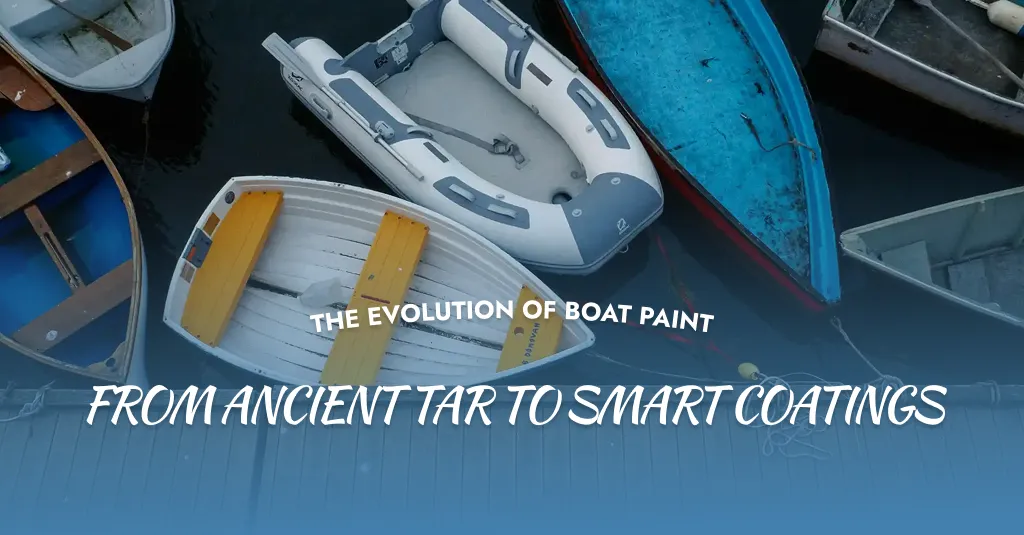
The Evolution of Boat Paint: From Ancient Tar to Smart Coatings
Few things are more beautiful than a well-maintained boat gliding over clear water. But beneath the shine and color lies centuries of innovation and discovery.
When we talk about the evolution of boat paint, we’re really telling the story of how humans learned to protect wooden hulls from rot, metal hulls from corrosion, and every vessel from the relentless assault of marine life, saltwater, and sun.
Today’s marine paints are technological marvels, self-polishing anti-fouling coatings, eco-friendly alternatives to toxic paints, and even smart coatings that resist biofouling without harming the ocean.
In this complete guide, we’ll explore the evolution of boat paint, from ancient tar to high-tech solutions, and see how far we’ve come and where we’re headed next.
Why Boat Paint Matters
Before diving into the evolution of boat paint, let’s answer a simple question: Why do boats need paint?
Paint on a boat is not just about looks it’s essential protection. Boat paint:
-
Shields the hull from water damage and corrosion.
-
Prevents marine organisms like barnacles and algae from attaching.
-
Improves fuel efficiency by reducing drag.
-
Extends the lifespan of the vessel.
A good paint job can mean the difference between smooth sailing and thousands spent on repairs.
Ancient Beginnings: Tar and Pitch
The evolution of boat paint starts in ancient times when early mariners used what they had tar and pitch.
Tar and Pitch: Ancient Greeks and Romans used pine tar and pitch to coat wooden hulls. These sticky substances sealed planks, kept out worms, and slowed water seepage.
Bitumen: Egyptians and Mesopotamians used bitumen a naturally occurring tar no reed boats and early wooden ships.
Advantages: Tar was easy to apply, waterproof, and accessible.
Disadvantages: It was messy, had to be reapplied often, and offered minimal protection against marine growth.
The Age of Copper Sheathing
By the 18th century, wooden ships faced a huge problem: barnacles, worms, and algae that slowed ships and rotted hulls.
The Royal Navy Solution:
In the 1760s, the British Royal Navy began using copper sheathing on ship hulls. Thin sheets of copper nailed to the hull prevented shipworms and reduced drag.
Pros: Copper deterred biofouling barnacles don’t like it.
Cons: It was expensive and required skilled labor.
Still, copper sheathing gave British ships a huge edge in naval wars and trade faster speeds and lower maintenance.
Early Marine Paints: Linseed Oil & Red Lead
Alongside copper sheathing, early shipbuilders started experimenting with primitive paints.
Linseed Oil: Linseed oil mixed with pigments became popular for above-water hull sections. It protected wood and added color.
Red Lead Primer: Red lead paint, discovered in the 18th century, became a standard primer for metal parts. It prevented rust and corrosion.
These early paints were a far cry from today’s high-tech coatings, but they marked a major step in the evolution of boat paint.
Industrial Revolution: Synthetic Marine Paints
The 19th century brought major breakthroughs. The Industrial Revolution gave rise to synthetic resins and new pigments.
Oil-Based Paints: New oil-based paints lasted longer and adhered better than raw linseed oil.
Lead Paints: Lead-based marine paints protected hulls but were highly toxic.
Copper-Based Paints: Shipbuilders mixed copper powder into paint to create early anti-fouling coatings. This kept barnacles off without needing expensive copper sheathing.
The Birth of Anti-Fouling Coatings
One of the biggest milestones in the evolution of boat paint was the invention of modern anti-fouling paint.
What is Anti-Fouling Paint?
Anti-fouling paint contains biocides chemicals that prevent marine life from attaching to the hull.
Early Biocides: Copper oxide became the standard. It’s still widely used today.
How It Works: The paint slowly releases copper ions, poisoning barnacles and algae.
Result: Cleaner hull, faster speeds, better fuel economy.
Modern Marine Paint: Layers of Protection
Fast forward to the 20th century: the evolution of boat paint saw an explosion of new materials.
Epoxy Primers: Strong, water-resistant primers that bond to fiberglass and metal hulls.
Polyurethane Topcoats: Durable, glossy finishes that resist UV rays and saltwater.
Multi-Layer Systems: Today, a typical marine paint job involves multiple layers primer, undercoat, anti-fouling, and topcoat each serving a specific role.
Environmental Concerns: The Downside of Early Anti-Fouling
While copper-based anti-fouling paints worked wonders, they came with a dark side: pollution.
TBT (Tributyltin): In the 1960s, TBT became a popular anti-fouling agent. It was incredibly effective but extremely toxic to marine life.
Global Ban: By the early 2000s, TBT was banned worldwide because it devastated marine ecosystems.
This shifted the industry towards safer, eco-friendly solutions, a key moment in the evolution of boat paint.
Today’s Innovations: Smart & Sustainable Coatings
In 2025, the evolution of boat paint has reached a fascinating stage.
Eco-Friendly Anti-Fouling: Modern coatings use non-toxic biocides or slick silicone surfaces that make it physically hard for organisms to stick.
Self-Polishing Paint: These paints gradually wear off, constantly exposing fresh biocide for consistent protection.
Nano Coatings: Some cutting-edge paints use nanotechnology to repel water and dirt.
Hybrid Coatings: Companies are developing paints that mix traditional and new technologies for maximum performance with minimal environmental impact.
Key Trends: Where Boat Paint Is Going
Copper-Free Paints: Reducing heavy metals to protect marine life.
Foul-Release Coatings: Instead of killing organisms, these make the hull too slippery for attachment.
UV-Resistant Coatings: Advanced pigments and binders to prevent fading.
DIY-Friendly Systems: Easier-to-apply products for recreational boaters.
Digital Monitoring: Some smart coatings even monitor hull condition and biofouling in real time!
How the Evolution of Boat Paint Impacts You
So, how does this long history matter to today’s boater?
Better Protection: Today’s paints last longer and work better.
Lower Costs: Modern coatings cut fuel use and maintenance bills.
Eco Responsibility: New options keep your boat clean without harming the ocean.
DIY Friendly: Many products are designed for weekend boat owners to apply themselves.
The Evolution of Boat Paint for Different Hull Types
The evolution of boat paint isn’t one-size-fits-all. Let’s see how it applies to different materials:
Fiberglass: Modern gelcoats protect the hull. Anti-fouling paint is added below the waterline.
Aluminum: Copper-based paints can corrode aluminum. Specialized paints are needed.
Steel: Epoxy primers are vital to prevent rust.
Wood: Classic wooden boats still need traditional varnishes and oil-based paints to seal planks.
Classic Boat Restorations: Preserving History
Many classic boat owners are obsessed with preserving authentic paintwork.
Restorers study old shipyard records to replicate historical paint colors and methods.
Museums often display antique hulls with tarred bottoms or copper sheathing.
Classic Yachts blend old-world finishes with modern protective coatings underneath.
How to Choose the Right Modern Marine Paint
Picking paint in 2025 is easier than ever. But options can be overwhelming.
Consult Experts: Reputable boatyards know what works best for your waters.
Consider Local Laws: Some regions restrict certain anti-fouling paints to protect sensitive ecosystems.
Match to Material: Always use paint compatible with your hull type.
Prep Properly: The best paint won’t stick if you skip sanding and priming!
Pro Tips: Maintaining Modern Marine Paint
Clean Regularly: Salt and algae weaken coatings over time.
Inspect Annually: Look for chips, blisters, or barnacle buildup.
Repaint on Schedule: Anti-fouling paint usually lasts 1–3 seasons.
Store Smart: Dry docking helps your paint job last longer.
Real Boater Stories
Mark’s Classic Schooner:
Mark spent five years restoring a 1920s schooner. He kept the original linseed oil topsides but upgraded the bottom to a slick, eco-friendly foul-release coating, blending history with modern tech.
Emma’s Eco Cruiser:
Emma switched from copper anti-fouling to a silicone-based slick coating. Her hull stays barnacle-free, and she loves knowing she’s not poisoning her local bay.
The next time you admire a sleek yacht or a sturdy fishing trawler, remember: beneath that glossy surface is centuries of trial, error, and innovation.
The evolution of boat paint is still happening new technologies emerge every year to keep our boats looking beautiful and the seas healthy.
So whether you own a classic wooden sloop or a high-tech carbon catamaran, you’re part of a proud tradition protecting your boat and the waters it sails.
Frequently Asked Questions (FAQs)
When did anti-fouling paint first appear?
The earliest versions appeared in the 18th century with copper sheathing and primitive copper powder paints.
Is copper paint still used?
Yes but many boaters are moving to copper-free options for environmental reasons.
How often should I repaint?
Most anti-fouling paints last 1–3 years. Topsides can last longer with good care.
Can I paint my boat myself?
Absolutely modern DIY kits make it easier than ever. Just follow the prep steps.
What’s the future of boat paint?
Expect more smart coatings, nano tech, and eco-safe biocides.





